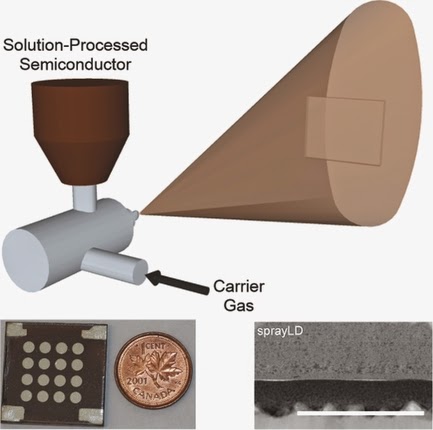Kramer and colleagues have just invented a new way to spray solar cells onto flexible surfaces using miniscule light-sensitive materials known as colloidal quantum dots (CQDs)—a major step toward making spray-on solar cells easy and cheap to manufacture.
“My dream is that one day you’ll have two technicians with Ghostbusters backpacks come to your house and spray your roof,” says Kramer, a post-doctoral fellow with the Ted Sargent group in The Edward S. Rogers Sr. Department of Electrical & Computer Engineering at the University of Toronto, and IBM Canada’s Research and Development Centre.
Solar-sensitive CQDs printed onto a flexible film could be used to coat all kinds of weirdly shaped surfaces, from patio furniture to an airplane’s wing. A surface the size of your car’s roof wrapped with CQD-coated film would produce enough energy to power three 100-Watt light bulbs—or 24 compact fluorescents.
He calls his system sprayLD, a play on the manufacturing process called ALD, short for atomic layer deposition, in which materials are laid down on a surface one atom-thickness at a time.
A colloidal quantum dot solar cell is fabricated by spray coating under ambient conditions. By developing a room temperature spray coating technique and implementing a fully automated process with near monolayer control—an approach termed as sprayLD—an electronic defect is eliminated resulting in solar cell performance and statistical distribution superior to prior batch-processed methods along with hero performance of 8.1%.
$1,000 to build sprayLD
The approach requires a way to produce inexpensive, spray-paintable solar cells.
"We started by buying a few art store airbrushes," Kramer says, "and it kind of grew from there."
The scientists stopped by an art store near the university and purchased a few airbrushes for a little over $100. They also bought three spray nozzles, including one fine-mist type from a vendor who mostly services the steel mill industry.
The device they created, which looks like something constructed during a Junkyard Wars episode, cost a little less than $1,000 to build — solar cells not included.
Next, the scientists want to build a bigger version of the sprayLD device to test whether increased size will affect its performance. They also need to improve the efficiency of the solar cell material. The performance benchmark for solar energy is typically a product that can convert 10 per cent of the sun's energy into electrical energy. They need to increase from 8.1%.
Advanced Materials - Efficient Spray-Coated Colloidal Quantum Dot Solar Cells
Read more »![]()
“My dream is that one day you’ll have two technicians with Ghostbusters backpacks come to your house and spray your roof,” says Kramer, a post-doctoral fellow with the Ted Sargent group in The Edward S. Rogers Sr. Department of Electrical & Computer Engineering at the University of Toronto, and IBM Canada’s Research and Development Centre.
Solar-sensitive CQDs printed onto a flexible film could be used to coat all kinds of weirdly shaped surfaces, from patio furniture to an airplane’s wing. A surface the size of your car’s roof wrapped with CQD-coated film would produce enough energy to power three 100-Watt light bulbs—or 24 compact fluorescents.
He calls his system sprayLD, a play on the manufacturing process called ALD, short for atomic layer deposition, in which materials are laid down on a surface one atom-thickness at a time.
A colloidal quantum dot solar cell is fabricated by spray coating under ambient conditions. By developing a room temperature spray coating technique and implementing a fully automated process with near monolayer control—an approach termed as sprayLD—an electronic defect is eliminated resulting in solar cell performance and statistical distribution superior to prior batch-processed methods along with hero performance of 8.1%.
$1,000 to build sprayLD
The approach requires a way to produce inexpensive, spray-paintable solar cells.
"We started by buying a few art store airbrushes," Kramer says, "and it kind of grew from there."
The scientists stopped by an art store near the university and purchased a few airbrushes for a little over $100. They also bought three spray nozzles, including one fine-mist type from a vendor who mostly services the steel mill industry.
The device they created, which looks like something constructed during a Junkyard Wars episode, cost a little less than $1,000 to build — solar cells not included.
Next, the scientists want to build a bigger version of the sprayLD device to test whether increased size will affect its performance. They also need to improve the efficiency of the solar cell material. The performance benchmark for solar energy is typically a product that can convert 10 per cent of the sun's energy into electrical energy. They need to increase from 8.1%.
Advanced Materials - Efficient Spray-Coated Colloidal Quantum Dot Solar Cells
Read more »
